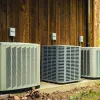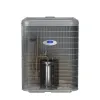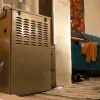It’s a crisp, quiet winter morning – the perfect time to bundle up and spend a few minutes outside with a hot cup of coffee. But as soon as you settle into your deck chair, you notice something is wrong. Your heat pump – the big, noisy outdoor component of your heating and air system – is covered in frost.
That isn’t normal, is it?
You’re pretty sure it’s not, and you’re seeing visions of a major repair bill in your future. Will you have to fix your heat pump? Will you have to replace it?
The answer to both questions is maybe, but maybe not. In many cases, there won’t be anything wrong with your heat pump at all.
But there could be.
It all depends on the dew point.
Lest the sight of ice or frost on your heat pump prompt an immediate call to an HVAC professional, let’s take a minute to understand why this might be happening. First of all, why does frost form on surfaces? The answer has to do with air and surface temperatures, relative humidity, and the current dew point.
Dew point, of course, refers to the temperature at which humidity in the air changes states and becomes liquid. You’ve seen frost on shrubs and grass in the mornings, right? That happens when:
- The surface temperature of those shrubs and grasses is below the dew point of the surrounding air, and
- The surface temperature of those shrubs and grasses is also below freezing
Well, the same thing can happen with your heat pump. All heat pumps contain refrigerant, which can be several degrees colder than the outdoor air. The temperature of the refrigerant inside your heat pump affects the surface temperature of the condenser. If it dips below the dew point and the freezing point, you might see frost on your heat pump.
And it’s completely normal when this happens. Nothing is broken.
So will the frost go away on its own?
Usually, yes. The frost will disappear on its own.
Your heat pump has a defrost cycle that will melt the frost when it kicks on. The hot refrigerant that the system uses to heat your home is sent back through the outdoor coil. This process increases the temperature of the surrounding components above the freezing point, and the frost goes away.
Chances are, this will happen pretty soon after you notice the frost is there. By the time you finish that cup of coffee, it might have melted already.
But my heat pump isn’t covered in frost. It’s covered in Ice!
Ok, a thick layer of frost or ice could indicate a real problem with your equipment. When a layer of frost forms between defrost cycles, it usually isn’t all that thick. It hasn’t been there long, and it will melt pretty quickly. But you’ll know something is up if:
- There’s so much frost/ice that air can’t easily pass through the heat pump fins
- The frost/ice has been on the coil for several hours and doesn’t seem to be melting.
Now it’s time to call your HVAC company. It’s not normal for lots of ice to form on your outdoor unit and stay there. In all likelihood, your system’s refrigerant charge is off or the components that control the defrost cycle are broken. Either way, it’s time for a repair.
Can you ignore your iced-over heat pump and leave it to chance? Sure, but you probably won’t be happy with the outcome. For starters, your heat pump won’t properly heat your house, so the system will switch to heat strips. This is a stupendously expensive way to produce heat, and you’ll notice when you get your next utility bill.
Eventually, you’ll also break your heat pump. That’ll be even more expensive.
Now you know when it’s time to freak out. Or not.
A little frost on the heat pump is no biggie. Just make sure it melts after a few hours, and you’re good.
On the other hand, a thick, growing layer of frost or ice is not a small matter, and you should call an HVAC professional to check things out.
So go ahead and finish that cup of coffee. Grab some breakfast. Put on some tunes. By the time you’ve done those things, you’ll probably have a frost-free heat pump.
If you don’t, you know what to do.






